The same old selections just won’t do when you’re in the mood for a meal that’s packed with diverse flavours, textures, and a dash of originality. It’s great to challenge your taste buds by drawing culinary inspiration from different civilizations. India is home to some of the most brilliant flavours and spice-forward preparations you will ever taste, while there are tasty dishes to sample from many other places as well.
Indian food is as diverse as its landscape considering that it is such a huge nation. There is always a new meal for you to taste, whether you live in a mountainous environment where fresh produce is scarce or a coastal town selling seashore fare. There are some foods you’ll want to cross off your Indian cuisine bucket list, regardless of whether you have the opportunity to visit the vibrant nation and sample the local cuisine firsthand or are forced to choose from a restaurant menu or guidebook. As a means to get you started on your exploration of the various flavours available, we’ve put up a list of the best Indian meals to try. These are the must-try foods, from traditional cuisines with their own regional variations to dishes influenced by British rule or nearby nations.
Rogan josh
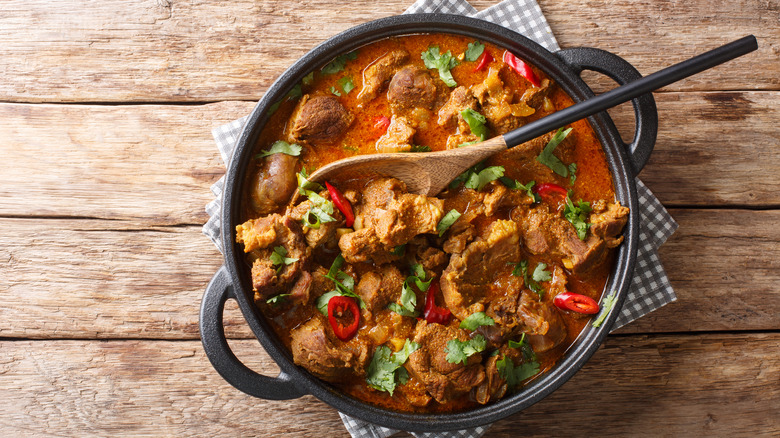
A bowl of rogan josh will do the trick if you’re searching for a hearty stew that will make you feel like you’re being hugged from all sides. Josh is not the origin of the name; rather, it gives a suggestion as to how it is prepared and tastes. Clarified butter (or ghee) and scalding heat are two terms for this dish’s ingredients in Persian, respectively. Additionally, the word “rogan” in Hindi refers to the colour red, which accurately describes the fiery curry. Today, rogan josh is frequently linked to the northern Indian area of Kashmir.
Let’s examine the additional components after discussing the two characteristics that give this dish its name: The meat of the goat or lamb is boiled in a flavorful stew made of ghee and thickened with yoghurt. The gravy also contains spices (cinnamon, clove, and cardamom), onions, garlic, and ginger. Although the list of spices is varied and some regional varieties include tomato, Kashmiri chillis are frequently a mainstay. Basmati rice or naan bread are all that are needed to finish this delectable stew as the meat cooks to the right tenderness and flavour.
Vindaloo
Although vindaloo is known for being among the spicier curries, there is more to it than meets the eye. The Portuguese, who introduced a pork dish marinated in vinegar and garlic to India in the 15th century, are most likely the ancestors of the Goan speciality. When palm wine was substituted for the vinegar, tamarind was added, along with spices like black pepper, cardamom, cinnamon, and chilli peppers (the latter of which was another Portuguese gift), and the meal quickly began to take on Indian characteristics. When vindaloo arrived in England a few decades later, it had previously been a mildly spiced curry made with pig cooked with a delicate balance of aromatics.
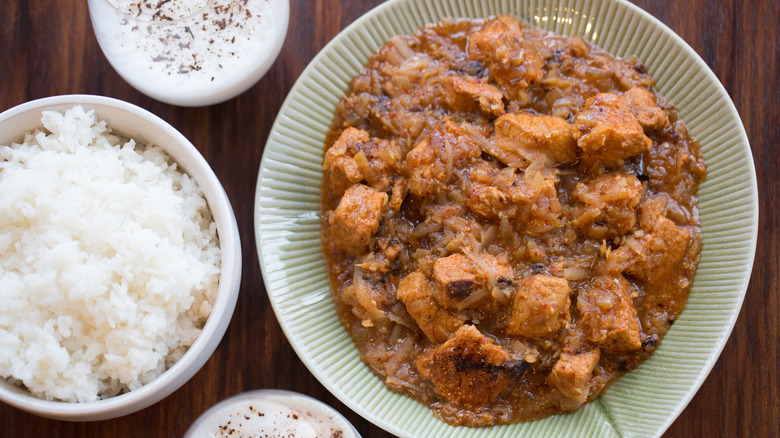
Vindaloo in Britain at the turn of the 20th century was intimately associated with “British lad culture,” according to Live History India, along with the change in flavours. More specifically, the aim was to make vindaloo as spicy as possible and compete to see who could finish a bowl of the thing rather than appreciating the subtleties of the spices. The South China Morning Post remembers how, during the 1998 FIFA World Cup, the English football team included a reference to vindaloo in their national hymn. Do yourself a favour and indulge in the sweet-and-sour feast if you can find a variation of the meal closer to the Goan classic.
Palak paneer
Palak paneer is the ideal method to get your fill of greens if you have trouble eating a lot of them. Paneer is a semi-firm, freshly pressed cheese, while palak is the Hindi word for spinach. The outcome is a delectable combination that may persuade you to consider combining the two frequently. When heated, paneer doesn’t melt; instead, it keeps its cube-like structure while stewing in the spinach, adding a textural contrast. The flavour and creamy consistency are enhanced with the addition of cream, onion, ginger, garlic, and garam masala in addition to the pureed spinach and fresh cheese. Every palak paneer preparation is unique since every kitchen has a different spice profile.
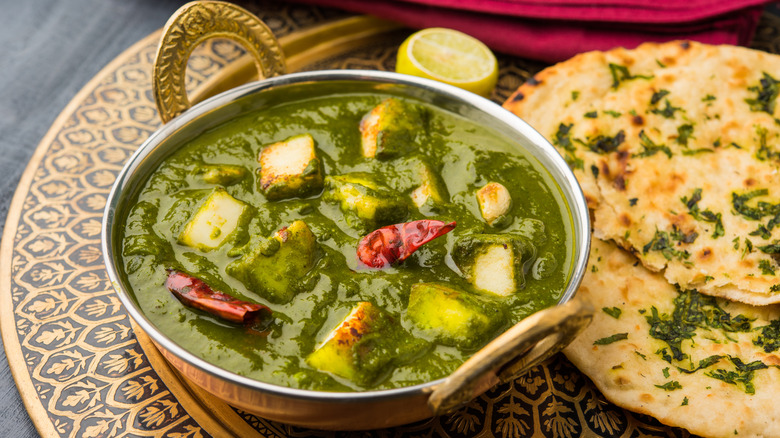
The Punjab region of northern India, where it is also known as saag paneer (due to the variety of leafy greens that can be used), is where this vegetarian dish has its roots. Palak paneer is a dish with rural origins that is frequently prepared to feed labor-intensive agricultural workers. This meal is a good vegetarian main dish because of the paneer, especially when served with its traditional side dishes like rice or bread. The ideal green side dish for a beef main dish or as part of a bigger variety, however, is this dish.
Biryani
Biryani is the way to go if you want a deliciously aromatic rice meal that will pique all of your senses. The BBC reports that the meal originates from Iran; birinj biriyan, which means “fried rice” in Persian, is another allusion to India’s complicated past. Indian biryani evolved into a variety of rice-based cuisines specific to each region, unlike how it changed into a separate dinner in Iran. However, Hyderabad is undoubtedly the city most closely linked to the dish. Extra-tender meat with warming spices like cinnamon, cloves, cardamom, and, most notably, saffron distinguish the famous Hyderabadi rendition
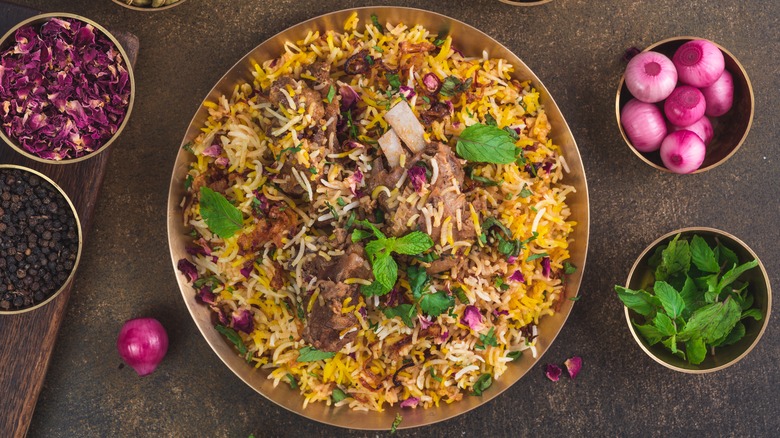 .
.
Regardless of the dish’s precise origin, all recipes share a few ingredients. In addition to meat (such as chicken, mutton, beef, and seafood in coastal areas), yoghurt marinade, a combination of aromatic whole and ground spices, and toppings like almonds, dried fruits, caramelised onions, and fresh herbs as garnishes, Saveur lists basmati rice (often long-grain). There are three common methods of preparation: stacking raw meat and uncooked rice, slow-cooking parboiled rice and raw marinated meat together, or partially boiling the two ingredients separately then steaming them together. You can anticipate rich, nuanced flavours and a meal that will delight you on all levels, regardless of the ingredients and cooking technique.
Masala dosa
Imagine it as the pancake of southern India, but thinner, more like a crêpe, and usually filled with savoury ingredients. Dosa batter, which has a crisp outside and a softer centre than flour pancake batter, is created from fermented lentils and rice. A Brahmin cook who was experimenting with fermented rice and came up with something quite different than the booze he was trying to create in secret is the subject of one origin story that explains the meaning of the term (dosha = to sin). Once you take a piece of this adaptable snack, you’ll be glad you skipped the rice wine.
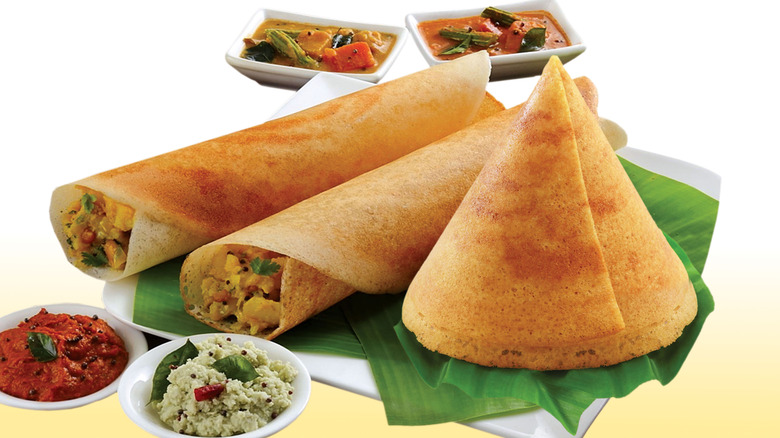
Popular fillings include onions, potatoes, chutney, coconut, and fresh coriander. There are many varieties. When it comes to masala dosa, a popular dish in Mysore, it is typically either filled with potato curry and butter or a variety of chutneys, such as tomato, mint, and coconut. The end result, which is also gluten-free, is ideal for momentarily sating your appetite at any time of day. Additionally, your food should have some gut-friendly bacteria as a result of the fermentation process, according to Indian Mirror.
Breads
There are at least 30 different types of bread in India, each unique to a region and prepared using a different grain and cooking technique, according to Michelin Guide. Make sure to conduct a lot of experiments. The fact that naan bread is so simple to locate in the United States is a significant plus, as the fluffy texture and scorched top are unrivalled. Flour is used to make the leavened bread, which is customarily baked in a tandoor oven and served hot with melted ghee on top. Naans, whether stuffed or plain, are excellent for sopping up a thick sauce.Contrarily, parathas omit the leavening step and instead continually fold the wheat dough over itself, resembling puff pastry. From breakfast to dinner, they consume the flaky, crispy flatbread either plain with savoury meals or packed with ingredients like potatoes, minced meat, and eggs.
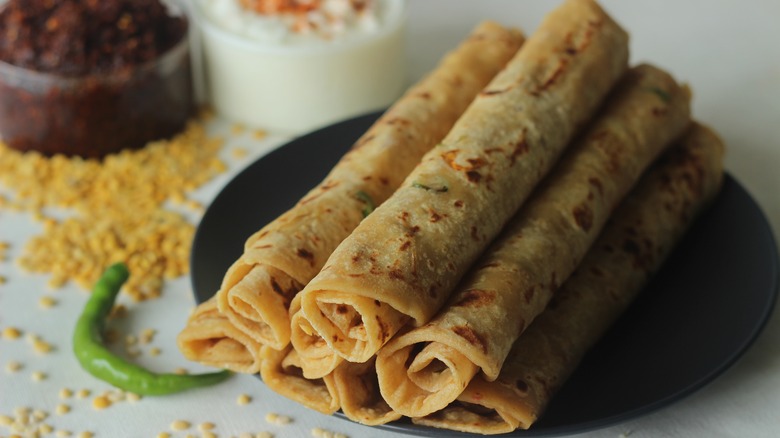
In the meantime, roti (also known as chapati) is just as essential to a meal as rice, which is significant in a nation that ranks second in the world for rice consumption. Chapati is made by combining whole wheat flour, water, and salt. It is then cooked in a heated skillet. The whole wheat flour gives the plain roti a delightful nuttiness and makes it ideal for scooping up stews and saucy foods.
Korma
This Persian Indian dish is another example of the blending of civilizations. A rich, silky stew, korma is traditionally cooked with meat, however vegetarian variations are available. You can choose from chicken, mutton, beef, paneer, or vegetables. Saffron, coriander, cumin, turmeric, and ginger are some of the standard suspects and give the dish its distinctive flavour. While yoghurt is frequently used to thicken sauces, local variations may use coconut milk, cream, or reduced milk, as well as additional ingredients like crushed nuts, dried fruits, and spices, depending on where you are eating.
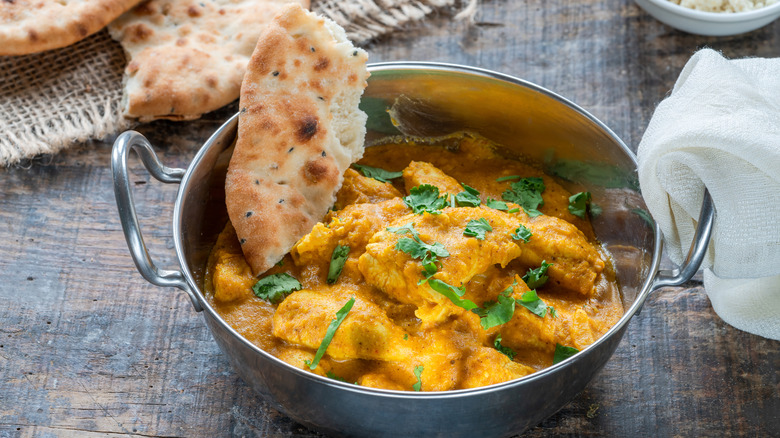
As a result, the flavour is velvety, nutty, mildly spicy, and has a tinge of sweetness that unites everything. Even while korma isn’t typically spicy, southern Indian versions could have a little kick. The word “korma,” which has Urdu roots, meaning to braise, which is one of the techniques used to produce delicate, tasty meat. Flatbreads like chapati, naan, or paratha are frequently used to accompany the flavorful stew.
Tandoori chicken
Once you taste the flavorful preparation, bright red tandoori chicken is simple to identify and difficult to forget. The yoghurt and spice marinade, as well as the preparation technique, all contribute to the flavour. Clay-made tandoor ovens are used to cook chicken (often with the bone in), which infuses the meat with flavour and gives off smokey scents. The marinade makes the meat’s interior moist and soft while the exterior gets beautiful and crispy. Cayenne, garlic, ginger, onion, garam masala, and red chilli powder are frequent ingredients in the spice mixture (tandoori masala), though it can vary.
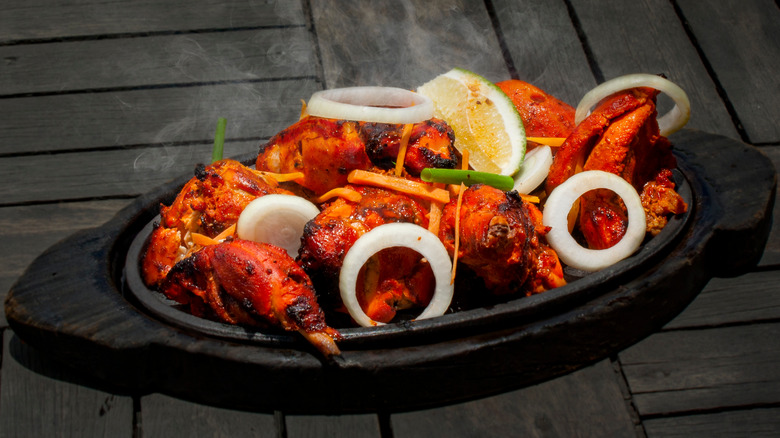
However, Kundan Lal Gujral was the first to cook chicken in a tandoor oven in Pakistan in the first part of the 20th century. Tandoor ovens are normally used for baking bread. He had to leave Pakistan quickly and settled in Delhi, where he made the wonderful meal famous. While the contemporary recipe may have originated from that, ceramic oven relics with chicken bones from around 2500 BCE have also been discovered. It is simple to comprehend why such a preparation would be so well-liked. Tandoor chicken and naan bread together make for a deliciously savoury and smokey supper.
Chicken tikka masala
Many more meals that incorporate the smokey flavours, spice mixture, and yoghurt marinade were inspired by tandoori chicken. One such dish is chicken tikka masala, which is among the easier to locate menu items in Indian restaurants in the United States. Chunks of grilled, boneless tandoori chicken are finished in a creamy tomato sauce, in contrast to tandoori chicken, which is often served dry. Depending on who is cooking, the sauce’s specific subtleties change, but tomato puree, cream, coconut milk, turmeric, and paprika are frequently added.
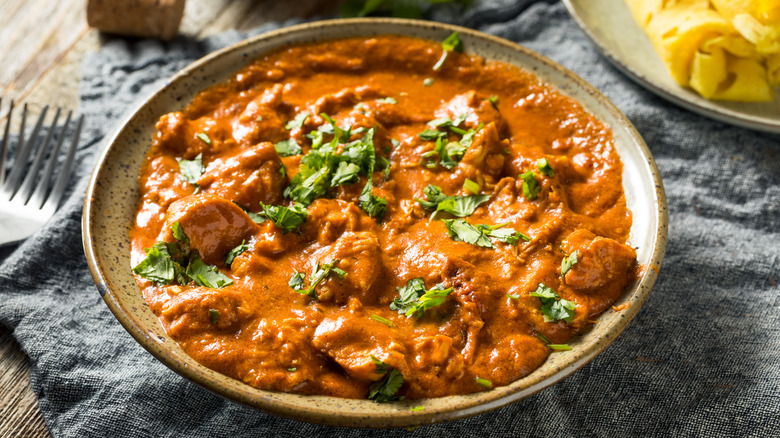
It’s unclear where chicken tikka came from, but it’s generally acknowledged to be one of the earliest dishes to fuse British and Indian cuisine. It was even designated as the nation’s dish by British Foreign Secretary Robin Cook in 2001, who also noted that it “is a perfect illustration of the way Britain absorbs and adapts external influences” (via The Guardian).
Also Read: According to Modi’s reasoning… Kanhaiya’s statement elicits criticism
That might be the case, despite the fact that chef Satpal Sharma tells the South China Morning Post that all of the ingredients and preparation are Indian. After giving the debate some thought, enjoy the hearty stew with naan or rice.
Madras curry
The base of a madras curry is a divine concoction of ground spices of the same name. Similar to other well-known Indian cuisines, it was made popular by the British, who referred to all Madras-based curries as such. In an effort to make the variety of Indian curries more approachable to local consumers, the dish as we know it today was created in the U.K. in the 1970s. In contrast to gentler stews like korma, madras curry was meant to be hot and spicy. The intensity of the heat can vary, thus raita (yoghurt with cucumbers and mint) is frequently given in addition to temper it. Not to be overlooked are the starchy accompaniments to the flavorful stew: naan bread and rice.
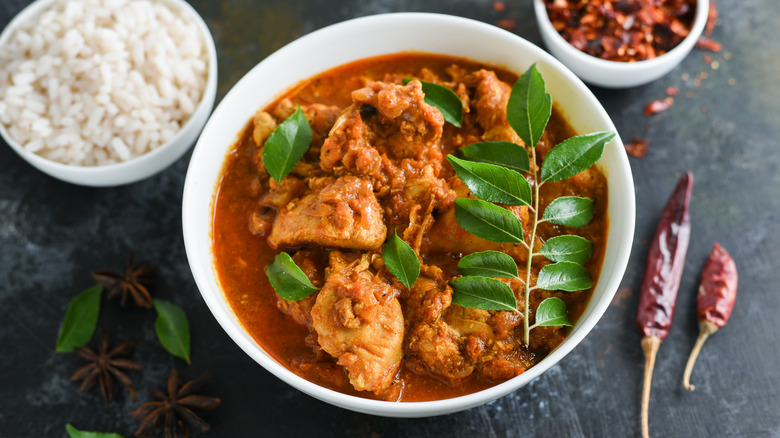
Although the spice mixture can be customised, cumin, coriander, cloves, fenugreek, mustard seeds, ginger, and red chillis are frequent ingredients. In truth, the brilliant red colour of a Madras-style curry is created by crushing the red chillis. The base of the stew is made using onions, garlic, ginger, tomato paste, and coconut milk in addition to the layers of spices. Here, chicken is preferred above other meats, and if lamb or beef is used instead, the dish changes to ghoulish madras.
Dal makhani
Both vegetarians and meat eaters will love the dal makhani dish. It turns out that the chef thought to be behind the creation of tandoori chicken is also behind the flavorful lentil meal. The use of dal makhani is regarded to have been a clever strategy to reduce trash from Delhi to Western Punjab and Pakistan. According to legend, Kundan Lal Gujral was the first to combine tandoori chicken with a rich tomato sauce; his grandson then combined the sauce with the family dal to create dal makhani.
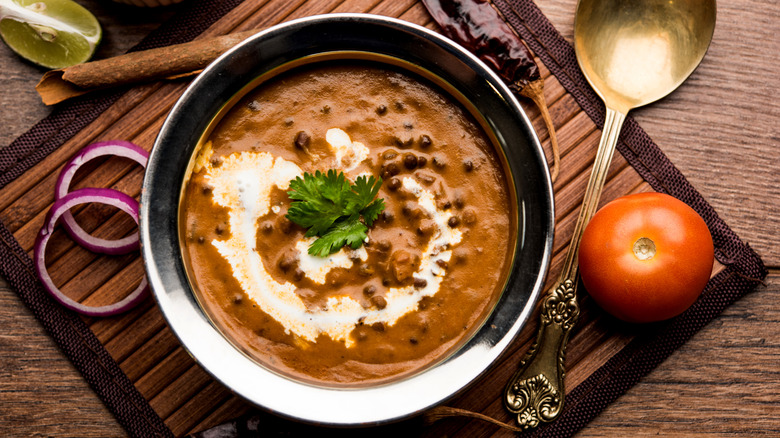
Red kidney beans and black lentils (sometimes referred to as urad) give the stew its thick viscosity. While “dal” alludes to lentils, “makhani” is Hindi for “butter,” a reference to the ghee-heavy dish that is topped with additional butter or yoghurt. Dal makhani is made out of a rich base as well as ginger, garlic, and chilies that are cooked in tomato sauce. The savoury lentil stew is delicious as a side dish with meat or as a vegetarian main dish, and is best paired with one of the many different types of local flatbreads.




